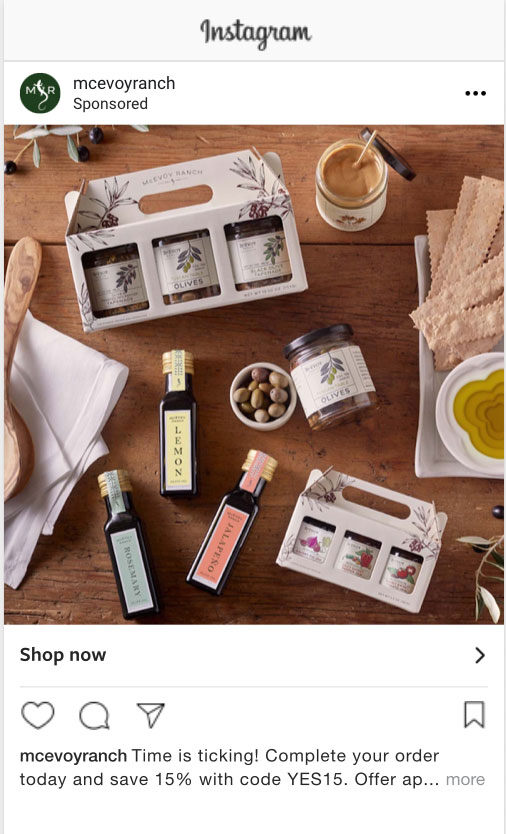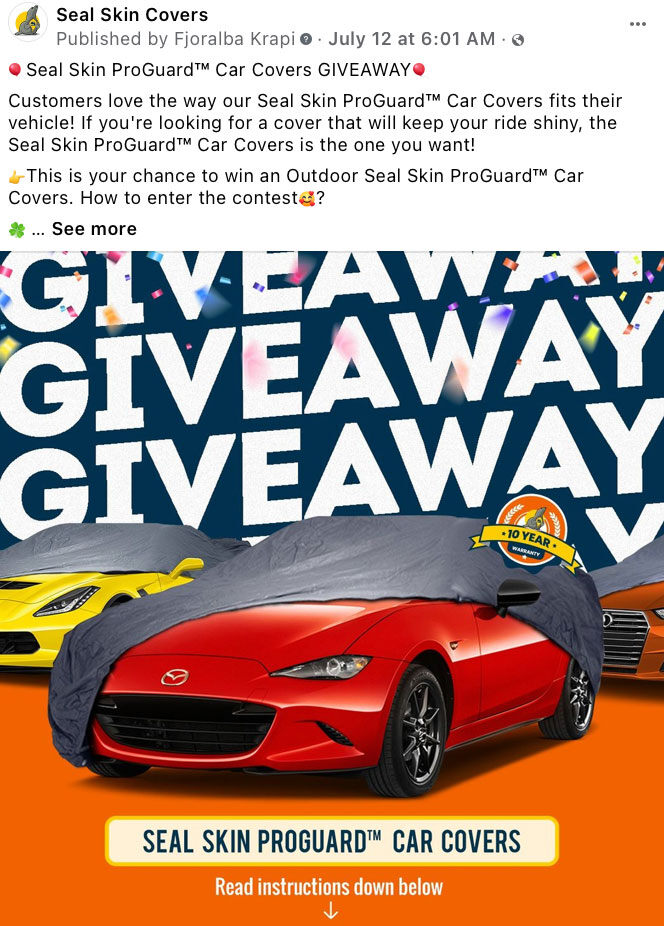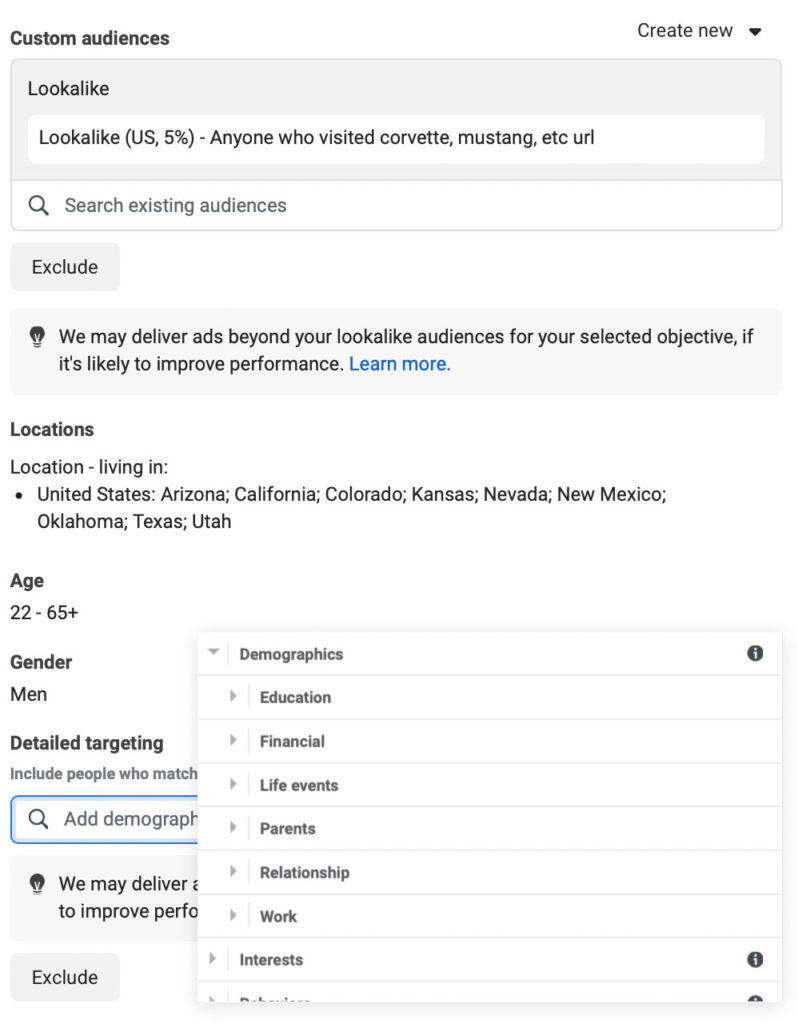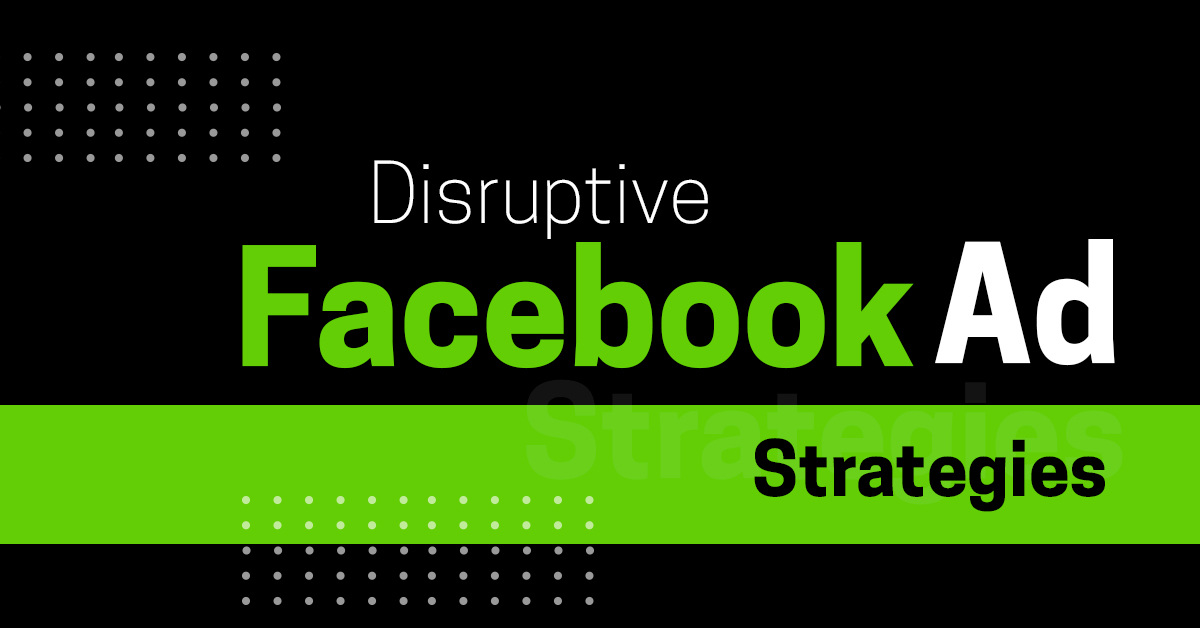Because Facebook is seen as a creative medium, it can be easy to assume that posting is more of an art than a science. But while there are undoubtedly creative aspects to building a successful Facebook marketing campaign, never forget that it’s a platform built on algorithms and analytics first.
To be a successful digital marketer, you have to learn how to work with the Facebook algorithm and use that synchronization to further your brand. It’s not enough to throw everything you have at the wall to see what sticks. You need to develop a thoughtful and purposeful Facebook ads strategy to get the most out of your marketing budget in 2022.
Facebook Ad Strategies
1. Setup A Facebook Conversion Funnel
You wouldn’t walk up to a stranger on the street and ask them to buy your latest product.
Why, you ask?
Well, because they’ve never heard of you or your company, they’re probably not looking to buy at that particular moment, and pushing people before they’re ready leaves a bad impression of your brand.
The same is true in digital marketing. Instead of running up to people and telling them they need to “Buy Now!”, you should create a conversion funnel.
A conversion funnel is just groupings of potential customers who are at different levels of familiarity and buying comfort with your brand. People at the top of the funnel are just learning about your products and need to be drawn in further. People at the bottom of the funnel are ready to buy and may just need one last little tap!
The classic sales model for conversion funnels is “Attract–Convert–Close–Delight.”

In other words: attract your potential customers with brand awareness, convert them into followers or customers with lead campaigns or free offers, close the sale, and then delight your customers with wonderful service and extras to keep them coming back!

A well-conceived Facebook ads funnel strategy means sorting your audience into funnel groups and custom designing ads for the people in those buckets to push them along the funnel.
2. Content Marketing and Facebook Ads
If you’ve been in sales or marketing long, you know that a warm lead is always better than a cold one. But if you’ve been in marketing or sales for long you also know that finding warm leads is easier said than done!
Luckily for you, we know that the best way to turn cold leads into warm leads is through content marketing! Think of content marketing as the “lead microwave” if you will.
“But Facebook is a short content platform!!” we can hear you wailing at your screen. And while that’s true, that doesn’t mean that you can’t utilize long-form, SEO-rich content as the foundation of your next Facebook campaign.
Simply write and publish high-quality content to your website and then link to that content in your Facebook posts. Share your post, ask your staff to share and like the post, and boost it to reach a wider audience.

Bam! Success.
Just remember to make this a key part of your Facebook ads targeting strategy. Content marketing is usually written for people at the very top of the marketing funnel. So, keep content general and educational and use their interest to push them further into the funnel.
3. Facebook Mobile and Instagram Ads
According to Statista, the average American spends between five and six hours on their phone per day. That’s a lot of scrolling. And a lot of potential facetime for your brand!
Use the human obsession with screen time to your advantage by making your Facebook ad format mobile-friendly! You’ve already customized your ad experience for your target audience by funnel. Further customize their experience by ensuring that you have ads specifically designed to work on their different devices.

Facebook allows you to create different ad formats and sizes for mobile and desktop. Make sure you’re optimizing your ads for peak performance.
4. Use Giveaways and Contests
A great way to generate leads is to create a high-value offer. The more valuable the offer, the more likely people are to give up their information or participate in some way.
If you work with physical products (soaps, foodstuffs, clothing, accessories, tech devices, etc.) and you need more Facebook followers, consider holding a giveaway. People get a free item in exchange for following your page, liking your post, or sharing it (or whatever you would like the currency to be).

You gain followers, your brand gains awareness, and all you have to lose is the cost of your giveaway item.
Contests are another great way to encourage participation and gather potential leads. Have people enter their emails for a chance at a gift card or a discount on services. You can then use those emails to send lead funneling email campaigns.
5. Use Lead Ads to Build Up your Marketing List
Speaking of leads and email campaigns–make sure that your Facebook ads targeting strategy includes “lead ads”. Lead ads are one of our favorite best practices for Facebook ads because they are so successful.
Lead ads allow people to enter their information and submit it to you without having to leave Facebook! If you’re new to digital marketing, you may not understand how ridiculously exciting that is for seasoned marketers.
You see, over 98% of website visitors never convert, even after you get them on your page. That number plummets even further if they have to switch platforms or leave what they were doing to fill out their information and complete the sale.
Streamline your lead gathering process and make it as easy and convenient as possible to maximize your conversion rate. Facebook makes this easy! Just create a custom audience (see above for a refresher), and set up a lead ads campaign within that marketing funnel.

You can offer free content downloads, enter users into contests, or gather emails for people interested in your newsletter. The world is your oyster with lead ads!
6. Incorporate Video and Carousel Ads
Whether you’re familiar with the terminology or not, you recognize carousel ads as soon as you see them. They come in multiple panels that auto-scroll from right to left. You can use carousel ads to display a variety of products or to tell a consistent branding story.

Studies have found that carousel ads are more visually stimulating and are ten times more likely to be clicked on than stationary ads. You can use up to ten slides, so get creative! Just make sure that first panel is dynamic enough to hold their attention and make them pause for the rest!
McEvoy Ranch’s Certified Organic Extra-Virgin Olive Oil is the hero that started it all. Complex, beautifully balanced, made from 7 Italian olive varieties, all grown on our family-owned California ranch.
See why Food & Wine Magazine raves about McEvoy Ranch as “The World’s Best”! Shop today to get 15% off with code YES15.
Posted by McEvoy Ranch on Monday, 7 March 2022
The same goes for video ads–they are more visually appealing, more dynamic, and much more likely to be interacted with. In fact, Adobe found that shoppers are 1.81 times more likely to purchase after watching a video when compared to shoppers viewing a static ad. That’s almost EIGHTY-FIVE PERCENT more return on your marketing budget.
Can’t beat those numbers.
7. Facebook Ads and Google Ads – The Power Couple
Now let’s talk about how your Facebook ads strategy 2022 can’t be complete without Google Ads! Far from competing, this dynamic duo can shoot your campaign right to the top when they’re synchronized correctly.
One of our favorite strategies is to hunt down competitor keywords and snipe them for your own brand! Cool right?
First, you use Facebook ads to drum up interest and get an idea of your target audience. Then you use that audience in a remarketing campaign in Google Ads. They call these RLSAs or Remarketing List Search Ads.
Basically, when someone who has interacted with your Facebook ad searches for one of your keywords, Google will automatically bid more on those keywords and put you higher in the paid search results!

You can use this for good (focusing on your own customers) or for evil (stealing your competitor’s customers)! But that’s between you and your branding team…
Facebook Ad Testing
1. Why You Need Facebook AB Testing and How It Works
Next, we’re going to discuss the importance of creating a Facebook ad testing strategy. While results sometimes speak for themselves, the only way to truly understand if you are maximizing your Facebook campaign is to A/B test it.
This allows you to determine what approaches, messaging, and design work best on your target audience. If your ads are performing poorly, A/B testing can help you understand why and how to do better. And if your ads are performing well, A/B testing can help you determine how you could do even better!
A/B testing is pretty much exactly what it sounds like. You take two versions of your Facebook ads strategy and run them simultaneously on similar audience parameters. The one that does better is the winner!
If you’ve ever had an argument over video versus carousel or what time of day to run your ads, A/B testing can clear up the mystery and help you better understand your Facebook audience targeting.
The Facebook Ads Manager allows you to easily set up A/B testing with any Facebook campaign you’d like to run. The analytics gathered will help you decide how to move forward and hone your marketing approach.
2. Different Levels of Facebook A/B Testing
Facebook divides its ads into three levels:
- The ad itself
- The ad set
- The overall campaign
At the ad level, you can A/B test any visual component of the ad. The images, the ad content and text, the call-to-action buttons, the headlines, etc.
At the ad set level, you can test delivery optimization levels, target audiences, and ad placements. Discover which times, geo-locations, and audiences work best for your services or products.

At the campaign level, the best thing to A/B test is the campaign objective.

These objectives determine the templates you’re offered and how the ads are delivered to your audience. You can choose from three main categories of “Awareness”, “Consideration”, and “Conversion”, as well as subcategories in each. To test out the differences, just submit two identical campaigns under two different objectives and watch the results!
3. Best Practices for Facebook Ads Testing
No matter what you’re A/B testing, just remember that you should be testing components one at a time. If you’re testing the ad itself, keep the ad set and campaign the same. If you’re testing the campaign objective, everything else should be identical.
If you change too many things at once, you won’t be able to tell which change made a difference in the results! Facebook ad testing strategy relies on consistent and reliable testing.
We know this is exciting stuff, but try to take it one step at a time!
4. 5 Facebook A/B Testing Ideas
1. Test Target Audiences
Testing Facebook audience targeting is one of our favorite use cases for A/B testing. Testing your audiences allows you to obtain a deeper understanding of your existing audience. And it also opens your eyes to new potential audiences and markets for your products and services!
And the more targeted your audience is, the more likely they are to convert–and convert more quickly! This saves you time, effort, and money in a big way.
So, start off by making custom audiences based on:
- Location
- Demographics
- Interests
Once you’ve done this, split them into groups with little to no overlap. Then test your ads and see if the answers surprise you!
2. Test Bidding Methods
Different bidding methods on otherwise identical ads can make a huge difference in your campaign ROI. Optimize for link clicks, for impressions, or for CPA and see where you’re getting the most bang for your buck.
3. Test Ad Types
This is one of the most obvious and frequently used A/B tests. Create similar messaging but within different formats. Carousel ads, video ads, GIF ads, stationary ads, content links–try them all and see which of your ads perform best.
You can further hone in on your results by testing different types of ads for each level of your sales funnel. You may find that video works best on top of the funnel while the carousel ads work best on bottom of the funnel prospects–or vice-versa!
4. Test Your Ad Designs
If you ever have a “creative disagreement” in the ranks, A/B testing can be the perfect way to set it to rest permanently. Launch identical campaigns with two different designs and see which performs best.
This can be a great way to test new logo ideas, different photography techniques, new color palettes, or whether you should invest in custom imagery instead of stock photos.
5. Test your Copy
This is a very important and often overlooked area for A/B testing. Especially with digital ads, it can be easy to assume that imagery is all. But the text of your messaging is just as important!
Try different turns of phrase to see if your audience prefers a catchy, casual tone or if they prefer polished and professional! Test out the use of specific hashtags and headlines to see what draws the most attention. And don’t forget to test out your call-to-action text on buttons!
Facebook Retargeting
1. Why Are Facebook Retargeting Ads So Important?
Facebook retargeting is a key factor in the success of your PPC strategy. Retargeting gathers information on the people who take actions that indicate they are already interested in your brand (clicking on a link, reading an article, sharing a post, etc.).
That information is then used to track and remarket your products or services to them, keeping your brand top of mind. This tactic is how those boots you looked at last week seem to follow you everywhere you go!
People who are remarketed to are much more likely to convert, which means you’re losing money if you’re not investing in retargeting.
2. Types of Retargeting Audiences
There are several types of retargeting audiences:
- Website activity
You can retarget people who have visited your website, clicked on specific product pages, or read certain blog posts. Create an ad campaign that is triggered by these specific actions and caters to the specific interest and level of the sales funnel in which they currently reside. - App Activity
You can create ads around app usage–not just the consistent users, but those who haven’t opened it in a while either. Create campaigns that send notifications about abandoned carts, long absences, etc. This invites them back in and recaptures their attention. - Customer Profiling
You know who your best customers are, so start building profiles and go out looking for other people who match that description! Try new geo-locations or demographics that resemble your current top customers. - Social Engagement
Target people who have interacted with your brand on social. They have already shown an interest which makes them a good source of warm leads.
3. How to Set Up Facebook Retargeting Campaigns
You can create remarketing campaigns in Facebook Ads Manager. They’ll allow you to create audiences based on your customer files, your website activity, your in-app activity, or your Facebook engagement data.
First, set up your Facebook pixel. Then create your custom audience in Facebook Ads. Choose the retargeting audience you’d like to use. Build your campaign. Add retargeting lists to your ad sets. Then create your retargeting ads within the sets.
4. Facebook Retargeting Best Practices
Here are a few tips to make sure you’re making the most of your remarketing campaigns:
- Remove customers who convert from your retargeting lists. There is NOTHING more annoying than looking at ads for the mattress you already bought a month ago.
- Customize your offers to your audiences. Don’t use “BUY NOW!” type content on a top-of-funnel audience. It comes off as pushy and can drive potential buyers away.
- There are 30, 60, and 90-day windows for retargeting. Choose the shortest possible for your brand’s sales cycle. People don’t like to be followed around for three months after clicking on something once. Choose the shortest window that makes sense and wait for them to interact again.
- Change your ads often. People get tired of seeing the same thing. Eventually, they won’t even see your ads anymore as they become familiar background noise. Instead, change out fresh designs often to stimulate interest.
5. 5 Facebook Retargeting Ideas
1. Start with All Website Visitors
The easiest and most often used retargeting campaign is the “all website visitors” campaign. Anyone who visits your site will receive remarketing reminders from your brand to keep it top of mind. This is the best place to start.
2. Blog Readers
Another great place to start is with your blog readers. Anyone who is reading more than one blog is interested in finding out more. So, make sure you set up campaigns that feed and fuel that curiosity. Send them FAQ information, product brochures, and informational downloads.
3. Facebook Engagements
When someone interacts on social, it usually means they like something about your product, design, or messaging. Use that as an open door to start feeding them more information about your brand!
4. Visited Landing Pages
If a user is on a landing page, it’s likely because they are searching for something specific. That means they’re in research or buying mode, so make sure you’re retargeting thoughtfully!
5. Existing Customers
We know we told you to take converters off your retargeting lists. And we stand by that! But you should also have a list of those who have purchased from you in the past that’s triggered by a new or similar product launch or a new conversion event.
For instance, if you sell shampoo and you know it takes an average of three months to use a bottle, make sure that the people who bought previously are seeing your new shampoo scents in three months when they’re ready to repurchase!
Facebook Ads Research
1. Why Do You Need Facebook Ads Research?
Successful Facebook ads audience targeting is based on solid and consistent research. It can take hours to complete, but it’s the foundation upon which you will build your successful Facebook ads strategy in 2022!
Research helps you identify new opportunities, keep track of your competition, validate your hypothesis and ideas, and lower your risk of making the same mistakes as other businesses in your industry.
2. How to Do Facebook Ads Research
Technically, you can find out just about whatever you want by researching. So before you dive in and get overwhelmed, make sure you make one to three solid goals.
For instance, you can decide that you’re going to research which calls to action are most used in your industry–and whether they seem to be successful. Check for tone in copy (do people use informal or professional) or see which colors people are using in design this season.
Whatever research you’re doing, make sure you have clear goals in mind. Then, start with the leading competition in your field!
3. Best Practices and Tools for Facebook Ads Research
The best tools are often your computer and a sense of curiosity.
But we have some suggestions for those of you who want to dive deeper into your competitive research!
Use Facebook as a spy tool
Use the “Why Am I Seeing This?” icon. It will literally explain which interests or demographics were set to help you see a certain ad. This can help you use similar tactics in your own campaign.
Facebook Ad Library
Check out the Facebook Ad Library. You can see all the ads that your competitors are running and take notes.
Analyze your competitors’ landing pages
Don’t just look at the ads! Make sure you’re clicking through to look at the landing pages too. This is where competitors can differentiate themselves. The best ads won’t work if they’re leading to crappy landing pages.
Learn from their mistakes and improve on their successes!
Reveal your competitors’ website A/B tests
You can do this through good old-fashioned spying, or you can use a tool like Stillo to help ensure that you’re staying on top of the best versions of your competition’s ads! Just make sure you’re using and improving on the winning version…
Take a look at Facebook Audience Insights
Don’t ignore Audience Insights. Knowing your audience is your number one way to succeed!
Analyze your past Facebook Ad campaigns
Knowing the competition is a powerful tool, but you’re the best source of information for what works and what doesn’t with your own customers. Make sure you’re looking at past campaigns–successes and failures–to understand how you can improve and streamline the process.
Contact SevenAtoms
Learn more about how to take your digital marketing to the next level and contact SevenAtoms today! From Facebook ads funnel strategy to design and analytics, we’re here to help you build the perfect Facebook ad campaign.










